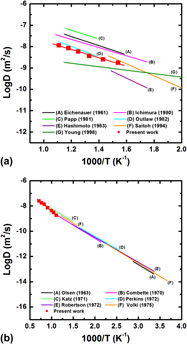Crossref Citations
This article has been cited by the following publications. This list is generated based on data provided by
Crossref.
Kim, Ki-Hyun
Shim, Jae-Hyeok
and
Lee, Byeong-Joo
2012.
Effect of alloying elements (Al, Co, Fe, Ni) on the solubility of hydrogen in vanadium: A thermodynamic calculation.
International Journal of Hydrogen Energy,
Vol. 37,
Issue. 9,
p.
7836.
Scott, Chris
Kenny, Steven D.
Storr, Mark T.
and
Willetts, Andrew
2013.
Modelling of dissolved H in Ga stabilised δ-Pu.
Journal of Nuclear Materials,
Vol. 442,
Issue. 1-3,
p.
83.
Shim, Jae-Hyeok
Ko, Won-Seok
Kim, Ki-Hyun
Lee, Heung-Soon
Lee, Young-Su
Suh, Jin-Yoo
Cho, Young Whan
and
Lee, Byeong-Joo
2013.
Prediction of hydrogen permeability in V–Al and V–Ni alloys.
Journal of Membrane Science,
Vol. 430,
Issue. ,
p.
234.
Jakse, N.
and
Pasturel, A.
2014.
Ab initio based understanding of diffusion mechanisms of hydrogen in liquid aluminum.
Applied Physics Letters,
Vol. 104,
Issue. 15,
Lee, Byeong-Moon
and
Lee, Byeong-Joo
2014.
A Comparative Study on Hydrogen Diffusion in Amorphous and Crystalline Metals Using a Molecular Dynamics Simulation.
Metallurgical and Materials Transactions A,
Vol. 45,
Issue. 6,
p.
2906.
Jakse, N.
and
Pasturel, A.
2014.
Hydrogen diffusion in liquid aluminum fromab initiomolecular dynamics.
Physical Review B,
Vol. 89,
Issue. 17,
White, P.D.
Barter, S.A.
and
Medhekar, N.
2016.
Hydrogen induced amorphisation around nanocracks in aluminium.
Engineering Fracture Mechanics,
Vol. 161,
Issue. ,
p.
40.
Zhou, X. W.
Ward, D. K.
and
Foster, M. E.
2018.
A bond-order potential for the Al–Cu–H ternary system.
New Journal of Chemistry,
Vol. 42,
Issue. 7,
p.
5215.
Paranjape, Priyanvada
Gopal, Priya
and
Srinivasan, S. G.
2019.
First-principles study of diffusion and interactions of hydrogen with silicon, phosphorus, and sulfur impurities in nickel.
Journal of Applied Physics,
Vol. 125,
Issue. 12,
Bal, Burak
Okdem, Bilge
Bayram, Ferdi Caner
and
Aydin, Murat
2020.
A detailed investigation of the effect of hydrogen on the mechanical response and microstructure of Al 7075 alloy under medium strain rate impact loading.
International Journal of Hydrogen Energy,
Vol. 45,
Issue. 46,
p.
25509.
Hachet, G.
Metsue, A.
Oudriss, A.
and
Feaugas, X.
2020.
The influence of hydrogen on cyclic plasticity of <001> oriented nickel single crystal. Part II: Stability of edge dislocation dipoles.
International Journal of Plasticity,
Vol. 129,
Issue. ,
p.
102667.
Wang, Jaemin
and
Lee, Byeong-Joo
2021.
Second-nearest-neighbor modified embedded-atom method interatomic potential for V-M (M = Cu, Mo, Ti) binary systems.
Computational Materials Science,
Vol. 188,
Issue. ,
p.
110177.
2021.
Waters, Brendon
Karls, Daniel S.
Nikiforov, Ilia
Elliott, Ryan S.
Tadmor, Ellad B.
and
Runnels, Brandon
2023.
Automated determination of grain boundary energy and potential-dependence using the OpenKIM framework.
Computational Materials Science,
Vol. 220,
Issue. ,
p.
112057.
Singha, Sourabh
and
Chatterjee, Abhijit
2024.
Advances in Clean Energy and Sustainability, Volume 1.
p.
173.
Yang, Linlong
Yu, Miaosen
Setyawan, Wahyu
Dong, Yibin
Ma, Wenxue
Jia, Huan
He, Yuan
Cai, Hanjie
Zhang, Xunchao
Wang, Xuelin
and
Gao, Ning
2024.
Melting point decrease induced by synergistic effect of proton implantation and radiation defects in aluminum.
Journal of Materials Science,
Vol. 59,
Issue. 34,
p.
16309.
Li, Xingxing
Wang, Junsheng
Yang, Xinghai
Xue, Chengpeng
Wang, Shuo
Li, Quan
Miao, Yisheng
Meng, Yanan
Kong, Decai
and
Lang, Yuling
2024.
Effect of solid solution treatment on the kinetics of hydrogen porosity evolution and mechanical properties in Al–Cu–Li alloys.
Vacuum,
Vol. 224,
Issue. ,
p.
113157.
Wang, Yuhao
Liu, Jiyan
Wang, Zhanrui
and
Du, Fengshan
2024.
Effect of pre-strain on hydrogen embrittlement of 7075 aluminum alloy and molecular dynamics simulation.
International Journal of Hydrogen Energy,
Vol. 88,
Issue. ,
p.
626.
Singha, Sourabh
and
Chatterjee, Abhijit
2024.
Atomistic-scale insights into hydrogen diffusion barrier in nickel hydride: Complex interplay between short- and long-range hydrogen arrangement and hydrogen concentration.
Computational Materials Science,
Vol. 241,
Issue. ,
p.
113044.



